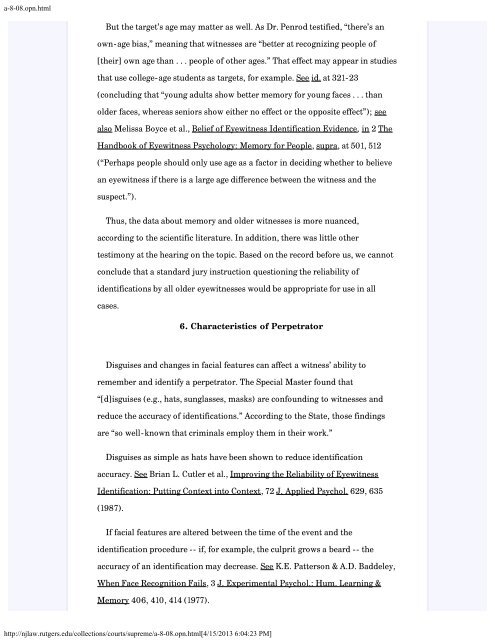State v. Henderson and the New Model Jury Charges - New Jersey ...
State v. Henderson and the New Model Jury Charges - New Jersey ...
State v. Henderson and the New Model Jury Charges - New Jersey ...
Create successful ePaper yourself
Turn your PDF publications into a flip-book with our unique Google optimized e-Paper software.
a-8-08.opn.html<br />
But <strong>the</strong> target’s age may matter as well. As Dr. Penrod testified, “<strong>the</strong>re’s an<br />
own-age bias,” meaning that witnesses are “better at recognizing people of<br />
[<strong>the</strong>ir] own age than . . . people of o<strong>the</strong>r ages.” That effect may appear in studies<br />
that use college-age students as targets, for example. See id. at 321-23<br />
(concluding that “young adults show better memory for young faces . . . than<br />
older faces, whereas seniors show ei<strong>the</strong>r no effect or <strong>the</strong> opposite effect”); see<br />
also Melissa Boyce et al., Belief of Eyewitness Identification Evidence, in 2 The<br />
H<strong>and</strong>book of Eyewitness Psychology: Memory for People, supra, at 501, 512<br />
(“Perhaps people should only use age as a factor in deciding whe<strong>the</strong>r to believe<br />
an eyewitness if <strong>the</strong>re is a large age difference between <strong>the</strong> witness <strong>and</strong> <strong>the</strong><br />
suspect.”).<br />
Thus, <strong>the</strong> data about memory <strong>and</strong> older witnesses is more nuanced,<br />
according to <strong>the</strong> scientific literature. In addition, <strong>the</strong>re was little o<strong>the</strong>r<br />
testimony at <strong>the</strong> hearing on <strong>the</strong> topic. Based on <strong>the</strong> record before us, we cannot<br />
conclude that a st<strong>and</strong>ard jury instruction questioning <strong>the</strong> reliability of<br />
identifications by all older eyewitnesses would be appropriate for use in all<br />
cases.<br />
6. Characteristics of Perpetrator<br />
Disguises <strong>and</strong> changes in facial features can affect a witness’ ability to<br />
remember <strong>and</strong> identify a perpetrator. The Special Master found that<br />
“[d]isguises (e.g., hats, sunglasses, masks) are confounding to witnesses <strong>and</strong><br />
reduce <strong>the</strong> accuracy of identifications.” According to <strong>the</strong> <strong>State</strong>, those findings<br />
are “so well-known that criminals employ <strong>the</strong>m in <strong>the</strong>ir work.”<br />
Disguises as simple as hats have been shown to reduce identification<br />
accuracy. See Brian L. Cutler et al., Improving <strong>the</strong> Reliability of Eyewitness<br />
Identification: Putting Context into Context, 72 J. Applied Psychol. 629, 635<br />
(1987).<br />
If facial features are altered between <strong>the</strong> time of <strong>the</strong> event <strong>and</strong> <strong>the</strong><br />
identification procedure -- if, for example, <strong>the</strong> culprit grows a beard -- <strong>the</strong><br />
accuracy of an identification may decrease. See K.E. Patterson & A.D. Baddeley,<br />
When Face Recognition Fails, 3 J. Experimental Psychol.: Hum. Learning &<br />
Memory 406, 410, 414 (1977).<br />
http://njlaw.rutgers.edu/collections/courts/supreme/a-8-08.opn.html[4/15/2013 6:04:23 PM]
















